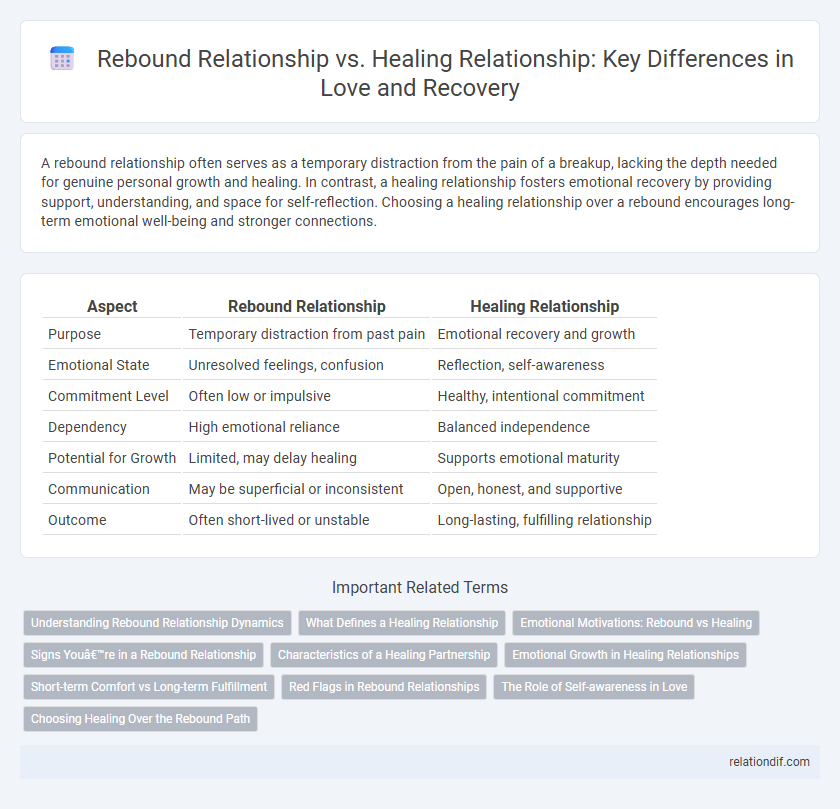A rebound relationship often serves as a temporary distraction from the pain of a breakup, lacking the depth needed for genuine personal growth and healing. In contrast, a healing relationship fosters emotional recovery by providing support, understanding, and space for self-reflection. Choosing a healing relationship over a rebound encourages long-term emotional well-being and stronger connections.
Table of Comparison
| Aspect | Rebound Relationship | Healing Relationship |
|---|---|---|
| Purpose | Temporary distraction from past pain | Emotional recovery and growth |
| Emotional State | Unresolved feelings, confusion | Reflection, self-awareness |
| Commitment Level | Often low or impulsive | Healthy, intentional commitment |
| Dependency | High emotional reliance | Balanced independence |
| Potential for Growth | Limited, may delay healing | Supports emotional maturity |
| Communication | May be superficial or inconsistent | Open, honest, and supportive |
| Outcome | Often short-lived or unstable | Long-lasting, fulfilling relationship |
Understanding Rebound Relationship Dynamics
Rebound relationships often serve as emotional distractions that prevent individuals from fully processing previous heartbreak, typically characterized by rushed intimacy and unresolved feelings. Healing relationships prioritize emotional recovery by fostering trust, communication, and self-awareness, enabling individuals to rebuild their sense of self and establish healthier connections. Understanding rebound relationship dynamics highlights the importance of timing and emotional readiness in forming lasting, meaningful partnerships.
What Defines a Healing Relationship
A healing relationship is defined by emotional growth, mutual support, and genuine understanding, allowing both partners to recover from past wounds and build trust. Unlike rebound relationships that often serve as distractions or quick fixes, healing relationships foster open communication and patience, emphasizing self-awareness and personal development. The core of a healing relationship lies in its capacity to nurture emotional resilience and create a safe space for vulnerability and long-term connection.
Emotional Motivations: Rebound vs Healing
Rebound relationships often stem from a need to quickly fill emotional voids caused by recent breakups, driven by fear of loneliness and validation seeking. Healing relationships prioritize emotional growth and self-reflection, focusing on building trust and genuine connection after recovery from past trauma. Understanding these emotional motivations helps individuals choose relationships that support long-term well-being rather than temporary comfort.
Signs You’re in a Rebound Relationship
Frequent comparisons to an ex and rushing into intense emotions are key signs you're in a rebound relationship, indicating unresolved feelings from a previous partnership. In rebound scenarios, partners often seek immediate validation rather than genuine connection, resulting in short-lived or unstable dynamics. Recognizing these patterns helps distinguish rebound relationships from healing relationships, where emotional processing and growth foster healthier, more sustainable bonds.
Characteristics of a Healing Partnership
A healing relationship fosters emotional growth, mutual respect, and open communication, allowing both partners to recover from past wounds and build trust gradually. Unlike rebound relationships, healing partnerships emphasize patience, self-awareness, and genuine support, creating a safe space for vulnerability and long-term connection. This type of relationship prioritizes mindful healing over quick emotional fixes, promoting lasting intimacy and personal development.
Emotional Growth in Healing Relationships
Healing relationships foster emotional growth by providing a safe space for self-reflection, vulnerability, and genuine connection, allowing individuals to process past traumas and build healthier attachment patterns. Unlike rebound relationships, which often serve as distractions to quickly alleviate loneliness, healing relationships emphasize mutual support and emotional maturity, leading to long-term personal development. Embracing healing relationships promotes resilience, improved communication skills, and deeper self-awareness essential for sustainable love.
Short-term Comfort vs Long-term Fulfillment
Rebound relationships often provide short-term comfort by distracting individuals from emotional pain but usually lack the depth needed for long-term fulfillment. Healing relationships, in contrast, foster emotional growth and self-awareness, creating a foundation for lasting intimacy and trust. Prioritizing healing over temporary solace promotes healthier connections and sustainable happiness in love.
Red Flags in Rebound Relationships
Rebound relationships often exhibit red flags such as emotional unavailability, rushing intimacy, and using the new partner as a distraction from past wounds. In contrast, healing relationships prioritize self-awareness, clear communication, and gradual emotional rebuilding to foster genuine connection. Recognizing avoidance behaviors and unresolved feelings in rebound scenarios is crucial to prevent emotional harm and promote healthier love dynamics.
The Role of Self-awareness in Love
Self-awareness plays a crucial role in distinguishing rebound relationships from healing relationships by enabling individuals to recognize their emotional needs and patterns. In healing relationships, self-awareness fosters growth and authentic connection, allowing partners to address past wounds constructively. Rebound relationships often lack this introspection, leading to temporary distractions rather than genuine emotional healing.
Choosing Healing Over the Rebound Path
Choosing a healing relationship over a rebound relationship fosters genuine emotional recovery and long-term growth after heartbreak. Healing relationships prioritize self-awareness, trust-building, and mutual support, contrasting with rebound relationships that often serve as temporary distractions driven by unresolved emotions. Focusing on healing promotes healthier intimacy and resilience, reducing the risk of repeating unhealthy patterns.
Rebound Relationship vs Healing Relationship Infographic

 relationdif.com
relationdif.com